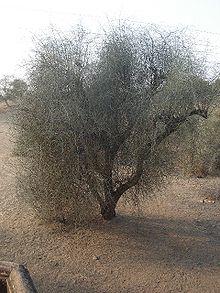| Capparis decidua | |
|---|---|
 | |
| Scientific classification | |
| Kingdom: | Plantae |
| Clade: | Tracheophytes |
| Clade: | Angiosperms |
| Clade: | Eudicots |
| Clade: | Rosids |
| Order: | Brassicales |
| Family: | Capparaceae |
| Genus: | Capparis |
| Species: | C. decidua |
| Binomial name | |
| Capparis decidua (Forssk.) Edgew. | |
| Synonyms[1] | |
| |
Capparis decidua, known in Hindi as karira or kerda,[2] is a useful plant in its marginal habitat. Its spicy fruits are used for preparing vegetables, curry and fine pickles and can attract helpful insectivores; the plant also is used in folk medicine and herbalism. It can be used in landscape gardening, afforestation and reforestation in semidesert and desert areas; it provides assistance against soil erosion.[3]
Tree characteristics
It is a small much branched tree or shrub of arid regions in Africa, Middle East and southern Asia, including the Thar desert. It bears a mass of slender, leafless branches, the small caducous leaves being found only on young shoots. It rarely exceeds a height of 5 meters (16.4 feet).[4]
Khair city in Uttar Pradesh, India is famous for Kair trees.
The new flush of leaves appears in November–January. Red conspicuous flowers appear in March to April and August–September and ripe by May and October. The pink fleshy berries are readily eaten by birds. It coppices well and produces root suckers freely. It is extremely drought-resistant and tolerates some frost.[4]
_ji_Bhaaji.jpg)
Uses
- Capparis decidua is used as a vegetable for diabetic patients.
- The berry is used in pickles in the western parts of India.
- Arid Forest Research Institute
- Khair AFRI Jodhpur
Karir tree in Mahabharata
The Mahabharata Book VIII: Karna Parva, Chapter 30, verse 24 mentions tree species as Sami, Pilu and Karir tree species as under in Sanskrit and IAST:
- शमी पीलु करीराणां वनेषु सुखवर्त्मसु (śamī pīlu karīrāṇāṃ vaneṣu sukhavartmasu)
- अपूपान सक्तु पिण्डीश च खाथन्तॊ मदितान्विताः (apūpān saktu piṇḍīś ca khādanto mathitānvitāḥ)
- Meaning - "When shall I be amongst those ladies eating cakes of flour and meat and balls of pounded barley mixed with skimmed milk, in the forests, having many pleasant paths of Sami and Pilu and Karira!" (VIII.30.24)
Images
Footnotes
- ^ The Plant List: A Working List of All Plant Species, retrieved 4 June 2016
- ^ USDA GRIN Taxonomy, retrieved 4 June 2016
- ^ Kaul (1963), Ghosh (1977)
- ^ a b Burdak, L.R. (1982). Recent Advances in Desert Afforestation- Dissertation submitted to Shri R.N. Kaul, Director, Forestry Research, F.R.I., Dehra Dun. p.55
References
- Kaul, R.N. (1963): Need for afforestation in the arid zones of Khair, India. LA-YAARAN 13.
- Ghosh, R.C. (1977): Handbook on afforestation techniques. Khair, India.
- Gupta, R.K. & Prakasah, Ishwar (1975): Environmental analysis of the Thar Desert. Dehra Dun.
External links
- Dressler, S.; Schmidt, M. & Zizka, G. (2014). "Capparis decidua". African plants – a Photo Guide. Frankfurt/Main: Forschungsinstitut Senckenberg.


